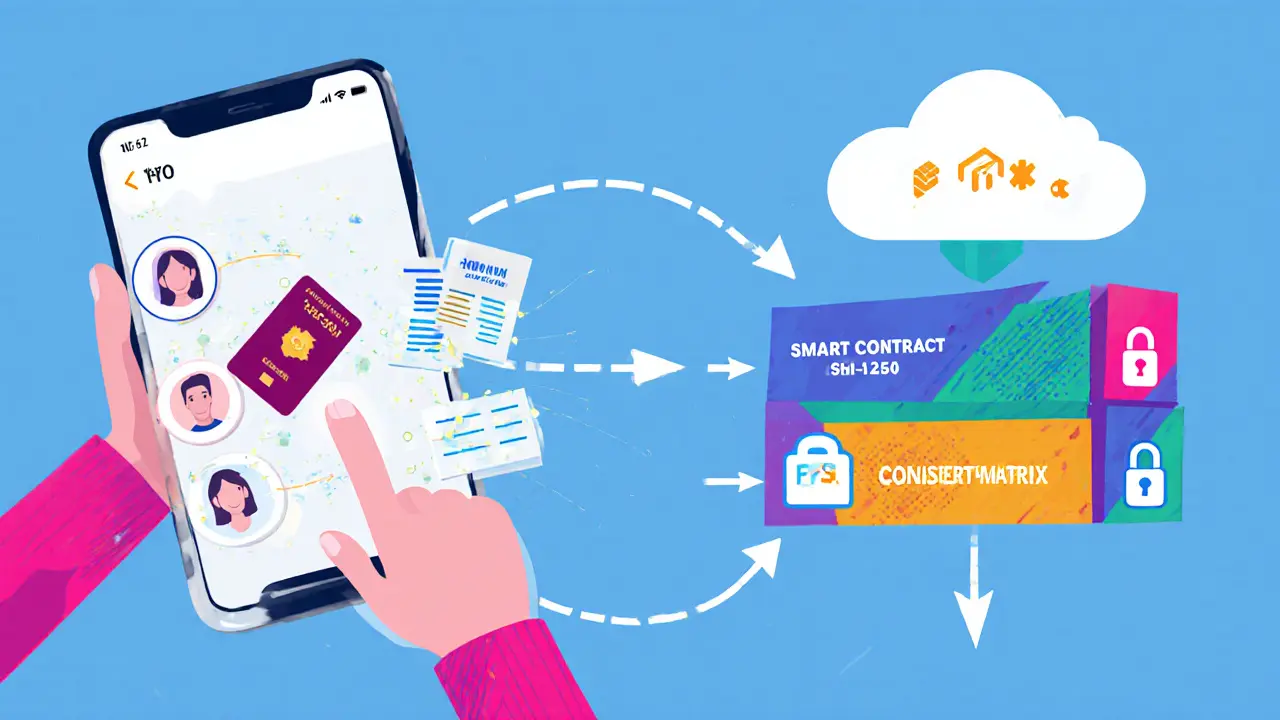Blockchain KYC Comparison Calculator
Traditional KYC
Legacy systems with centralized databases and manual processes.
- Onboarding Cost $15-$50
- Verification Time Hours to Days
- Data Redundancy High
Blockchain KYC
Decentralized, secure, and reusable digital identity system.
- Onboarding Cost $8-$20
- Verification Time Seconds to Minutes
- Data Redundancy Low
Calculate Potential Savings
Estimated Results
Total Costs
- Traditional KYC $0.00
- Blockchain KYC $0.00
Savings & Improvements
- Cost Savings $0.00 (0%)
- Time Improvement 0%
How This Works
This calculator shows how blockchain-based KYC can dramatically reduce costs and improve verification times. Traditional KYC involves manual checks and multiple redundant processes, while blockchain KYC uses immutable hashes and smart contracts for instant verification.
- Cost Reduction: Reusable digital identities eliminate repeated document collection and processing.
- Time Efficiency: Instant verification reduces wait times from days to minutes.
- Security: Immutable records provide tamper-proof audit trails for regulators.
When you sign up for a bank account or a crypto exchange, you’re forced to upload the same passport, driver’s licence and proof‑of‑address over and over again. KYC (Know Your Customer) is the regulatory process that forces those repetitive checks. Blockchain (a distributed ledger that stores data in immutable, cryptographically linked blocks) promises to turn that pain point into a one‑time, reusable digital identity. In this guide we’ll break down the mechanics, the real‑world benefits, and the challenges you’ll hit when you try to replace a legacy KYC stack with a blockchain KYC solution.
Why Traditional KYC Falls Short
Legacy KYC systems are built around siloed databases owned by each financial institution. The workflow usually looks like this:
- Customer submits identity documents to Institution A.
- Institution A runs manual or semi‑automated checks.
- Data is stored in a centralized repository that only Institution A can read.
- When the same customer wants a product from Institution B, they repeat step 1.
That redundancy creates three big problems:
- Cost: Each onboarding costs the institution anywhere from $15 to $50 in labor and software fees.
- Friction: Customers abandon applications when asked for paperwork a second time.
- Security risk: Multiple copies of the same sensitive data increase the attack surface for data breaches.
Regulators around the world demand that the data be accurate and auditable, but they don’t prescribe a single way to store it. That regulatory flexibility is a window for blockchain to step in.
Core Building Blocks of a Blockchain‑Based KYC System
A functional blockchain KYC platform rests on four technical pillars:
- Digital Identity Layer: A user‑controlled profile that contains hashed references to identity documents. The profile lives on a permissioned ledger, meaning only vetted participants (banks, regulators) can read or write to it.
- Cryptographic Hash Functions: When a document is uploaded, the system creates a SHA‑256 hash. The hash is stored on‑chain; the actual file can sit in encrypted cloud storage or IPFS. Any tampering changes the hash, instantly flagging the record.
- Smart Contracts: Self‑executing code that checks whether the required KYC fields are present, verifies the hash, and then emits a "verified" event. Contracts also manage consent - they only expose a user’s data to a requesting institution if the user signs the transaction.
- Permissioned Network: Unlike public blockchains, a permissioned network (e.g., Hyperledger Fabric) restricts participation to known entities. This keeps transaction throughput high and satisfies privacy regulations.
When these components talk to each other, the onboarding experience collapses from minutes of manual work to a few clicks.
Step‑by‑Step: How a Customer Goes From Zero to Verified
- Profile Creation: The user downloads a KYC app, uploads a passport scan, utility bill, and a selfie. The app encrypts the files, stores them in off‑chain storage (often IPFS), and computes a cryptographic hash for each file.
- On‑Chain Registration: The hashes, along with a pointer (IPFS CID) and a public key, are submitted to a smart contract on the permissioned ledger. The transaction is signed with the user’s private key, proving ownership.
- Verification by a Trusted Provider: A bank or third‑party verifier reads the hashes, fetches the encrypted files, decrypts them (with the user’s consent), and runs AML/KYC checks. If everything passes, the verifier updates the smart contract with a "verified" status flag.
- Consent Management: The smart contract stores a consent matrix. When the user wants to open an account at a new bank, they simply sign a transaction granting that bank read‑access to the verified hashes.
- Instant Onboarding: The new bank reads the on‑chain verification flag, validates the hash matches the stored documents, and instantly approves the account without asking for any additional paperwork.
All of these steps happen in seconds, and the user retains control over who sees their data.

Real‑World Benefits: What Companies Actually Gain
Implementations reported by early adopters such as a European consortium of banks and a crypto‑exchange in Southeast Asia show concrete gains:
- Cost Reduction: By re‑using a single verified profile, onboarding costs fell by up to 60% (from $30 per customer to $12).
- Speed: Verification time dropped from an average of 3‑5 days to under 10 minutes.
- Compliance Auditing: Every data access is recorded on the ledger, providing regulators with a tamper‑proof audit trail. The audit logs satisfy GDPR’s “right to access” and the US’s AML reporting requirements.
- Customer Satisfaction: A 2023 user survey (Statista) showed a 45% increase in Net Promoter Score for services that adopted a reusable digital identity.
These numbers are not just hype; they stem from pilot projects that used Hyperledger Fabric as the backbone and stored documents on IPFS with AES‑encrypted keys.
Traditional KYC vs. Blockchain KYC: A Side‑by‑Side Comparison
| Aspect | Traditional KYC | Blockchain KYC |
|---|---|---|
| Data Storage | Centralized databases per institution | Permissioned ledger + encrypted off‑chain storage |
| Onboarding Cost per Customer | $15‑$50 | $8‑$20 (after network effects) |
| Time to Verify | Hours to days | Seconds to minutes |
| Data Redundancy | Multiple copies across banks | Single immutable hash reference |
| Regulatory Audit Trail | Manual logs, prone to tampering | Automatic on‑chain immutable logs |
| Customer Consent Control | Limited, often “opt‑out” only | Smart‑contract‑driven, granular permissions |
Choosing the Right Blockchain Platform
Not every blockchain fits KYC needs. Public chains like Bitcoin or Ethereum provide immutability but lack native privacy and cannot guarantee transaction speed for high‑volume onboarding. Permissioned frameworks fill that gap.
Hyperledger Fabric is the most cited choice in academic papers and early‑stage pilots. Its modular architecture lets you plug in custom consensus mechanisms, and its channel feature isolates data between subsets of participants-perfect for banking consortia.
Other contenders include:
- Corda: Designed for financial institutions, strong privacy model, but steeper licensing costs.
- Quorum: An Ethereum‑compatible permissioned chain; good if you already have Solidity smart contracts.
The decision matrix depends on existing tech stacks, regulatory requirements, and the desired level of decentralization.

Implementation Challenges You’ll Face
Even with a clear roadmap, teams hit three common roadblocks:
- Regulatory Alignment: Different jurisdictions define “personal data” and “consent” differently. You’ll need a legal‑tech team that can translate GDPR, CCPA, and local AML rules into smart‑contract logic.
- Scalability: Permissioned networks can handle a few thousand transactions per second, but a global banking network may need to shard the ledger or use off‑chain verification patterns.
- Inter‑Institution Coordination: For the network effect to work, at least three or four major banks must join. That requires governance models, shared standards, and a consortium agreement.
Addressing these issues early-by drafting a shared data‑sharing framework and choosing a platform with proven enterprise performance-greatly smooths the rollout.
Future Outlook: Where Blockchain KYC Is Heading
Industry analysts predict three trends for the next five years:
- Standardized Protocols: Bodies like the X‑RegTech Alliance are drafting open‑source schemas for KYC data that can be universally consumed by any permissioned ledger.
- Cross‑Border Data Sharing: With the EU’s eIDAS and the US’s upcoming Digital Identity Act, regulators are leaning toward interoperable, consent‑driven identity hubs.
- AI‑Enhanced Verification: Smart contracts will trigger off‑chain AI models that perform facial recognition and document authenticity checks, feeding the result back to the ledger for immutable proof.
When these pieces click together, you’ll see a world where you open a bank account, rent a car, and sign a lease-all with a single verified digital identity.
Quick Checklist Before You Launch
- Define the digital identity data model (hashes, pointers, consent matrix).
- Select a permissioned blockchain (Hyperledger Fabric is a safe bet).
- Build smart contracts that enforce KYC rules and record consent.
- Integrate off‑chain storage (IPFS or encrypted cloud) for raw documents.
- Run a regulatory sandbox test with at least two financial partners.
- Set up monitoring for throughput and latency; plan for sharding if needed.
Follow these steps and you’ll dramatically cut onboarding costs while giving customers true ownership of their data.
Frequently Asked Questions
What is the main advantage of using blockchain for KYC?
The biggest win is a reusable, tamper‑proof digital identity that customers control. It eliminates repeated document submissions, cuts compliance costs, and creates an immutable audit trail for regulators.
Is a public blockchain like Ethereum suitable for KYC data?
Usually not. Public chains are transparent by design, which conflicts with privacy laws. Permissioned blockchains such as Hyperledger Fabric or Corda let you restrict who can read the data while keeping the benefits of immutability.
How does consent work in a blockchain KYC system?
Consent is encoded in a smart contract. The user signs a transaction granting a specific institution read‑access to their hashed identity data. The contract can be updated at any time, allowing the user to revoke access instantly.
What technical skills are needed to build a blockchain KYC solution?
You’ll need familiarity with a permissioned blockchain platform (e.g., Hyperledger Fabric), smart‑contract programming (Go, JavaScript, or Solidity for Corda/Quorum), cryptographic primitives (hashing, AES encryption), and a solid understanding of AML/KYC regulations.
Can blockchain KYC be integrated with existing legacy systems?
Yes. Most implementations use REST APIs or gRPC to bridge legacy databases with the blockchain network. The legacy system pushes verification results to the smart contract, which then updates the on‑chain status.


This is actually huge. I work in fintech in India and we're drowning in paperwork. Imagine if a customer could just tap once and get approved everywhere? No more uploading the same passport 5 times in a month. Game changer.
Yeah right. Blockchain for KYC? Next they'll tell us drones will deliver our coffee. All this tech just means more complexity for nothing. I'd rather just email a PDF.
bro this is legit. i tried this with a crypto exchange last month and it took 7 mins to get verified. no calls, no emails, no 'please resend your utility bill'. the hash thing works. just make sure your phone camera is in focus lol
Great breakdown. One thing people miss: the real win isn't just speed-it's reducing fraud. With centralized systems, a single breach leaks everyone's docs. With blockchain, even if someone hacks the off-chain storage, they can't forge the hash. That's security you can actually measure.
Why are we trusting some global blockchain when our own government can't even manage ID cards properly? This feels like outsourcing our security to Silicon Valley billionaires. Stick to paper. At least paper doesn't get hacked by some kid in Estonia.
It’s funny how we think tech solves human problems. The real issue isn’t the system-it’s that we don’t trust each other. Blockchain just gives us a fancy way to say ‘I don’t believe you, so here’s a hash.’ Maybe we need less tech and more trust.
OMG this is so needed in India 😭 We wait weeks just to open a bank account. My aunt had to go to 3 branches with 4 different copies of her Aadhaar. If this works, it’ll change lives. 🙌 Let’s make it happen!
So you're telling me we spent 20 years building centralized databases so we could now... use blockchain to do the same thing but slower and more expensive? 🤦♀️ I'm not impressed. Also, who's paying for all these IPFS nodes? My tax dollars?
As someone from Nigeria where identity fraud is rampant, this could be revolutionary. But let’s be real-most people here don’t have smartphones or stable internet. You can’t solve a digital problem with analog infrastructure. We need to fix the basics first.
wait so if i lose my private key... i lose my identity? like... permanently? no reset? no customer support? 😬 that sounds terrifying. who's gonna help my grandma if she forgets her password?
The regulatory challenges outlined here are non-trivial. Jurisdictional conflicts around data sovereignty could stall adoption for years. Legal teams will need to be embedded in development teams-not added as an afterthought.
Blockchain KYC is just another Silicon Valley fantasy. Real people need IDs, not hashes. Let the banks handle it. We don’t need another crypto buzzword.
Look, I used to be skeptical too. But after helping a small credit union implement this last year, their onboarding time dropped from 4 days to 12 minutes. Customers cried happy tears. This isn’t sci-fi-it’s the future, and it’s already here. Stop doubting. Start building.
Just did this for my startup account and it was smooth as butter 🚀 no more waiting. blockchain is not hype its just logic. also i used emojis so u know im serious